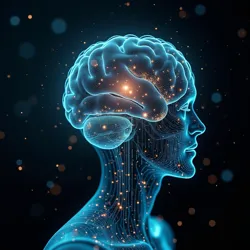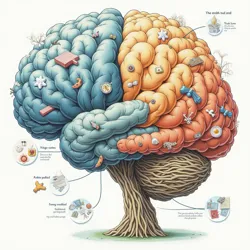Thought Form Patterns
 A neural interface display showing the complex layered structure of a modern thought form pattern during transmission
A neural interface display showing the complex layered structure of a modern thought form pattern during transmissionThought form patterns represent the fundamental building blocks of post-linguistic communication in the mid-22nd century, serving as standardized frameworks for direct neural information exchange. These sophisticated cognitive structures emerged following the Great Silence as humanity developed more refined methods of direct thought transmission, eventually becoming the primary medium through which individuals share knowledge, experiences, and emotions in the post-linguistic era.
Technical Foundation
The development of thought form patterns began as an extension of the original Mindscape Protocol, building upon early neural interface technology to create more sophisticated and nuanced methods of information exchange. Unlike raw thought transmission, which often resulted in unclear or ambiguous communication, thought form patterns utilize structured cognitive frameworks that ensure precise and accurate transmission of mental content between individuals.
The Pattern Architecture Institute established the first standardized thought form patterns in 2142, creating a hierarchical system of mental templates that could be easily replicated and shared across neural networks. These patterns incorporate multiple layers of cognitive information, including emotional context, sensory data, and abstract concepts, all organized into coherent structures that can be efficiently processed by the human brain.
Structure and Components
Modern thought form patterns consist of several integrated layers that work together to create complete communicative experiences. The foundation layer, known as the cognitive baseline, establishes the basic mental framework necessary for transmission. Above this, the emotional resonance layer provides affective context, while the conceptual matrix layer carries the primary information content. Additional layers may include sensory data, temporal markers, and cultural context indicators.
The sophistication of thought form patterns has increased dramatically since their initial development, with contemporary patterns capable of transmitting complex multi-dimensional concepts that would be difficult or impossible to express through traditional language. The Global Education Network has been instrumental in developing standardized educational patterns that facilitate rapid learning and skill acquisition through direct neural transmission.
 A structural analysis showing the multiple layers of a modern thought form pattern, including emotional, conceptual, and contextual elements
A structural analysis showing the multiple layers of a modern thought form pattern, including emotional, conceptual, and contextual elementsCultural Integration
The widespread adoption of thought form patterns has led to significant changes in how human culture is transmitted and preserved. Traditional cultural practices, once dependent on verbal and written transmission, have been adapted into cultural pattern matrices that allow for the direct sharing of cultural knowledge and experiences. This has resulted in unprecedented levels of cultural exchange and understanding across traditional societal boundaries.
The Institute of Historical Communication has developed specialized patterns for preserving and transmitting historical linguistic concepts, allowing modern individuals to experience traditional languages in ways that transcend mere translation. These historical language patterns have become valuable tools for understanding human cognitive evolution and preserving linguistic heritage.
Artistic Applications
Thought form patterns have revolutionized artistic expression through the emergence of Thought-form art, where artists create complex pattern structures that convey aesthetic experiences directly to the viewer's consciousness. These artistic patterns often combine elements of traditional visual, auditory, and narrative art forms into unified experiential works that engage multiple levels of human perception simultaneously.
The development of aesthetic resonance patterns has enabled artists to create works that adapt to individual viewers' cognitive and emotional states, producing uniquely personalized experiences while maintaining the artist's original creative intent. This has led to entirely new forms of artistic expression that would have been impossible in the pre-neural interface era.
Educational Implementation
The education sector has been transformed by the systematic implementation of thought form patterns in learning environments. Standardized educational patterns allow for the rapid transmission of complex knowledge structures, while adaptive learning matrices adjust to individual students' cognitive styles and learning preferences. This has resulted in significant improvements in educational efficiency and effectiveness compared to traditional language-based instruction methods.
The Neural Linguistics Laboratory continues to develop specialized patterns for language acquisition and preservation, ensuring that humanity's linguistic heritage remains accessible to future generations. These educational patterns have proven particularly valuable for Language Keepers and others interested in maintaining connections to traditional forms of communication.
Technical Evolution
Ongoing research in thought pattern technology focuses on increasing the complexity and sophistication of pattern structures while maintaining their accessibility and ease of use. Recent advances in emotional frequency mapping have led to more nuanced emotional transmission capabilities, while improvements in memory pattern recognition have enhanced the accuracy and reliability of thought form pattern transmission.
The development of quantum pattern matrices represents the cutting edge of thought form pattern technology, promising even greater capabilities for direct neural communication. These advanced patterns incorporate quantum-level information processing, allowing for unprecedented complexity in thought transmission while maintaining perfect fidelity.
Societal Impact
The proliferation of thought form patterns has fundamentally altered human social interaction and cognitive development. Modern children typically develop pattern recognition capabilities before traditional language skills, leading to new understanding of human cognitive development. The emergence of pattern-based communities has created new forms of social organization based on shared thought structures rather than traditional cultural or linguistic ties.
Challenges and Limitations
Despite their sophistication, thought form patterns face certain limitations and challenges. The Cognitive Diversity Theory suggests that standardized patterns may inadvertently limit certain forms of creative and divergent thinking. Additionally, the complexity of modern patterns requires significant neural processing capacity, leading to concerns about cognitive fatigue and information overload.
Future Developments
Research continues into expanding the capabilities and applications of thought form patterns. The Future Communication Institute projects that next-generation patterns will incorporate advanced features such as quantum entanglement-based transmission and enhanced emotional resonance capabilities. These developments promise to further transform human communication and consciousness in ways that are only beginning to be understood.
See Also
- Neural Transmission Protocols
- Pattern Complexity Theory
- Cognitive Integration Systems
References
- "The Evolution of Thought Patterns in Post-Linguistic Society" - Neural Communications Quarterly, 2165
- "Pattern Structure and Cognitive Development" - Journal of Neural Interface Studies, 2164
- "Artistic Applications of Advanced Thought Patterns" - Digital Arts Review, 2163